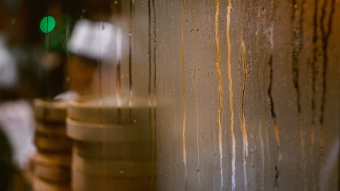On these hot June days, are you finding that your skin feels extra sticky or clammy when you are inside your home? Do your short, hot showers result in long-term fog conditions in your bathroom?
Don’t ignore these symptoms – you just might have a humidity problem in your home.
Humidity is the amount of moisture in the air. A certain amount of humidity is a good thing. Overly dry air can cause itchy, uncomfortable nasal passages, static electricity, and dry skin amongst other problematic experiences for homeowners. Excess humidity, in contrast, can make your home feel warmer than it really is and creates the proper conditions for harmful bacteria to thrive.
Moisture is created in the home through ordinary household activities like cooking, showering, and so on. Although your air conditioner may be running steadily, you may still need a dehumidifier to clear the air and help keep your home’s interior dry.
Let’s review the signs indicating your home may have a humidity problem, and what you can do about it.
1. Excessive heat in your home
If your home feels damp and stuffy every time you walk in the front door, you might want to take a moment to check on your dehumidifier. Updating your ventilation and heating and cooling systems will help, but this problem will only be fully treated if your dehumidifier is working properly and efficiently.
A dehumidifier extracts water from the air. Here at Applewood Air, we recommend that you install a whole-home dehumidifier rather than the smaller portable units for optimal efficiency and impact. ENERGY STAR® qualified dehumidifiers will also use up to 20 per cent less energy to remove the same amount of moisture as a similarly-sized conventional dehumidifier. This makes it an excellent cost-saving option.
Humidity can put additional pressures on your household energy consumption, so ensure that your energy-efficient home upgrades are taking humidity levels into account.
2. Problems with insulation and drafts in your home
If you are noticing drafts in your home, it may be that problems with humidity have damaged your home’s insulation.
Drafts might also be a sign that your insulation is letting in moisture, thus contributing to the humidity problems in your home. Take some time to inspect the sealing around your fixtures, windows and doors. If you see any problems, re-seal and caulk around fixtures to help fight humidity.
You can also add some weatherstripping around windows and doors to protect against unwanted moisture in your home.
3. Troubles with regulating temperatures in your home
If you have been feeling that your home is too warm, simply turning on your air conditioning unit may not be getting at the root cause of the issue.
Rather than focusing only on regulating temperatures in the home, take humidity levels into consideration.
A dehumidistat may be of value if you have moisture problems in the home. A dehumidistat will measure the moisture in the air around it, in the same way that a thermostat monitors temperature.
Once you have set your preferred humidity level on the dehumidistat, it will automatically turn on a fan when the humidity level goes over your setting. This fan is typically located in your bathroom to avoid the challenges posed by having moist showers indoors.
Wondering if you have a humidity problem? Our knowledgeable service team is happy to assist – give us a call today to enjoy the comfort of proper indoor temperature and humidity levels in your home!






